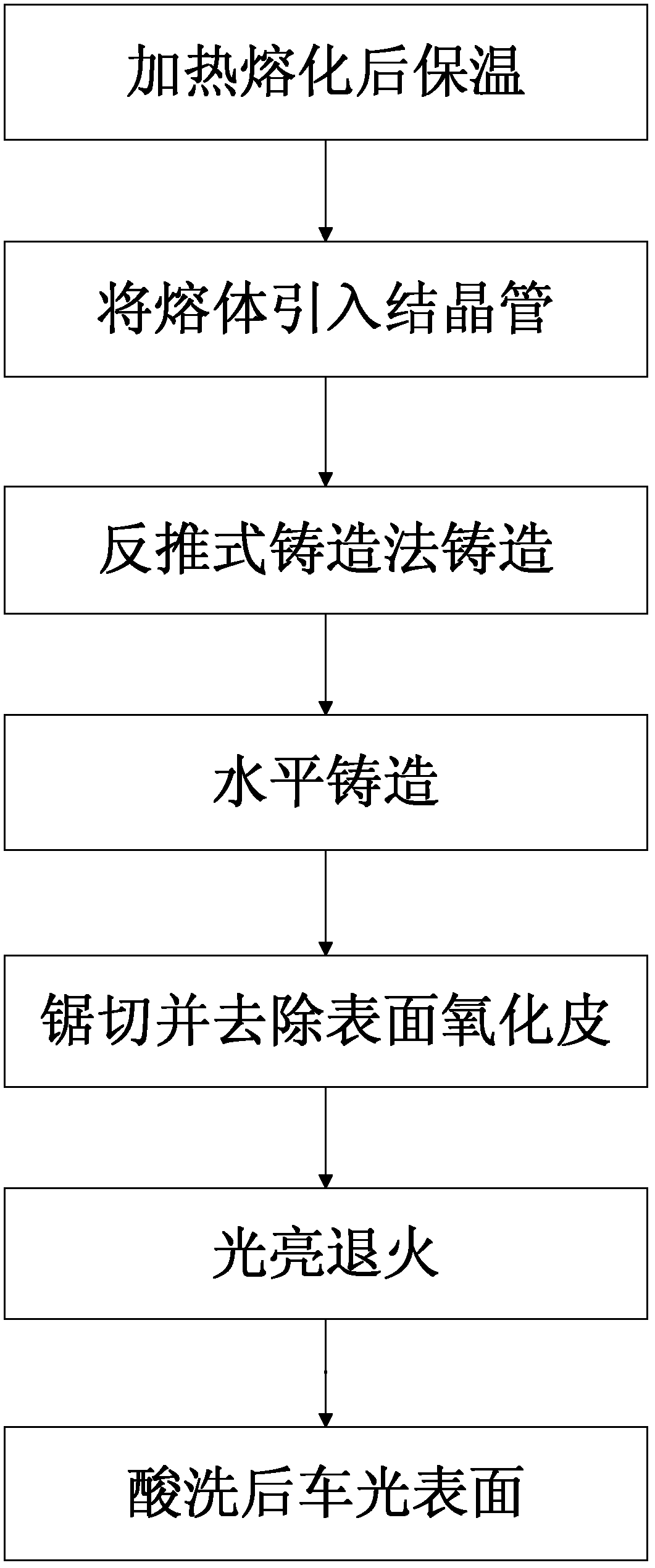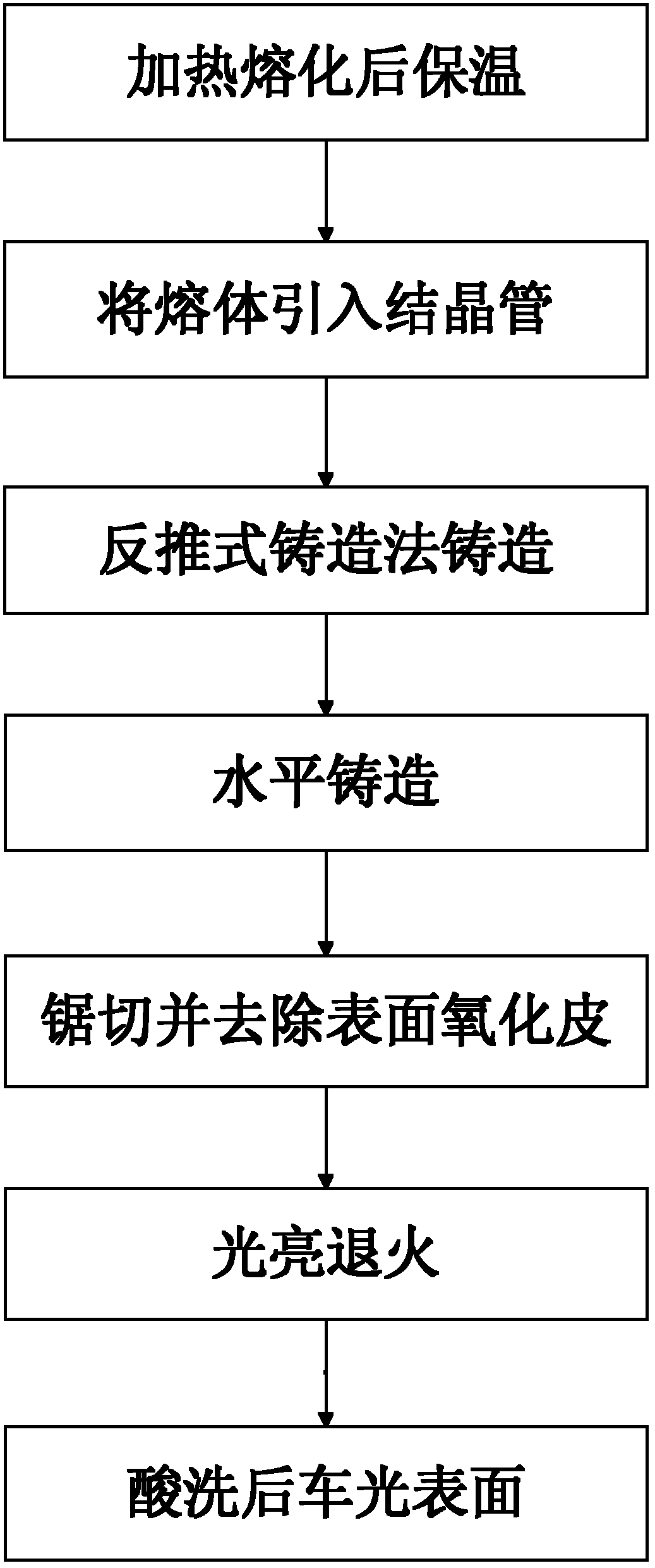Wrought alloy pig for nuclear steam turbine and manufacturing method thereof
A production method and alloy ingot technology, which is applied in the field of wrought alloy ingots for nuclear power steam turbines and its production, can solve the problems that bronze ingots cannot meet the demand and are not easy to be secondary formed, so as to enhance the forgeability and ductility, reduce the internal and external Pores, loss reduction effect
- Summary
- Abstract
- Description
- Claims
- Application Information
AI Technical Summary
Problems solved by technology
Method used
Image
Examples
Embodiment 1
[0039] A wrought alloy ingot for nuclear power steam turbines. The alloy ingot components include aluminum, iron, manganese, rhenium or lanthanum or cerium, and copper. The components of the alloy ingot are respectively: 13% by weight of aluminum and 1% by weight. %, manganese 5%, rhenium or lanthanum or cerium 0.2%, copper 80.8%.
[0040] The manufacturing method of the above-mentioned wrought alloy ingot for nuclear power steam turbine includes the following steps:
[0041] i. Placed in a power frequency electric furnace according to the ratio of aluminum 13%, iron 1%, manganese 5%, rhenium or lanthanum or cerium 0.2%, and copper 80.8%, heated to 1280°C, and kept warm after being completely melted;
[0042] ii. The alloy is prone to segregation during casting. A draft tube is used to directly introduce the melt into the mold. The mold is coated with lubricating oil. The furnace is covered with carbon black with a thickness of 10-20mm to reduce the chance of oxidation and slag gener...
Embodiment 2
[0050] A wrought alloy ingot for nuclear power steam turbines. The alloy ingot components include aluminum, iron, manganese, rhenium or lanthanum or cerium, and copper. The components of the alloy ingot are respectively 15% by weight and 2% by weight. %, manganese 7%, rhenium or lanthanum or cerium 1%, copper 75%.
[0051] The manufacturing method of the above-mentioned wrought alloy ingot for nuclear power steam turbine includes the following steps:
[0052] i. Place it in a power frequency electric furnace at a ratio of 15% aluminum, 2% iron, 7% manganese, rhenium or lanthanum or cerium 1% and copper 75%, and heat it to 1280°C, keep it warm after being completely melted;
[0053] ii. The alloy is prone to segregation during casting. A draft tube is used to directly introduce the melt into the mold. The mold is coated with lubricating oil. The furnace is covered with carbon black with a thickness of 10-20mm to reduce the chance of oxidation and slag generation. ;
[0054] iii. Use r...
Embodiment 3
[0061] A wrought alloy ingot for nuclear power steam turbines. The alloy ingot components include aluminum, iron, manganese, rhenium or lanthanum or cerium, and copper. The composition of each component of the alloy ingot by weight percentage is: aluminum 16%, iron 3 %, manganese 9%, rhenium or lanthanum or cerium 1.5%, copper 70.5%.
[0062] The manufacturing method of the above-mentioned wrought alloy ingot for nuclear power steam turbine includes the following steps:
[0063] i. Placed in a power frequency electric furnace at a ratio of 16% aluminum, 3% iron, 9% manganese, rhenium or lanthanum or cerium 1.5% and copper 70.5%, heated to 1280°C, and kept warm after being completely melted;
[0064] ii. The alloy is prone to segregation during casting. A draft tube is used to directly introduce the melt into the mold. The mold is coated with lubricating oil. The furnace is covered with carbon black with a thickness of 10-20mm to reduce the chance of oxidation and slag generation. ; ...
PUM
| Property | Measurement | Unit |
|---|---|---|
| thickness | aaaaa | aaaaa |
| elongation | aaaaa | aaaaa |
| elongation | aaaaa | aaaaa |
Abstract
Description
Claims
Application Information
 Login to View More
Login to View More - R&D
- Intellectual Property
- Life Sciences
- Materials
- Tech Scout
- Unparalleled Data Quality
- Higher Quality Content
- 60% Fewer Hallucinations
Browse by: Latest US Patents, China's latest patents, Technical Efficacy Thesaurus, Application Domain, Technology Topic, Popular Technical Reports.
© 2025 PatSnap. All rights reserved.Legal|Privacy policy|Modern Slavery Act Transparency Statement|Sitemap|About US| Contact US: help@patsnap.com



